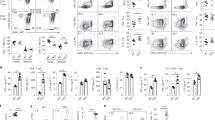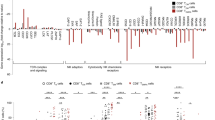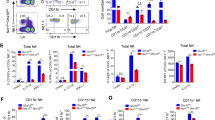Abstract
EAT-2 is an adaptor expressed in innate immune cells, including natural killer (NK) cells. It is closely related to the adaptor SAP, which regulates signaling lymphocyte activation molecule (SLAM)–related receptors by recruiting the kinase FynT to the receptors. Here we have studied the function of EAT-2 in NK cells by creating mice lacking or overexpressing EAT-2. Like SAP, EAT-2 was associated with the SLAM-related receptor 2B4 in NK cells. However, unlike SAP, EAT-2 was an inhibitor of NK cell function. EAT-2 repressed natural cytotoxicity and interferon-γ secretion by a mechanism involving tyrosine phosphorylation of its C terminus.* We have demonstrated a similar function for the adaptor ERT, a newly identified SAP family member expressed in mouse NK cells. These data identify a previously unknown mechanism of NK cell inhibition. Moreover, they indicate that EAT-2 and SAP have distinct and at times opposing functions in natural immunity.
* NOTE: In the version of this article initially published online, the sixth line of the abstract was incorrect; it should begin “…its C terminus.”
This is a preview of subscription content, access via your institution
Access options
Subscribe to this journal
Receive 12 print issues and online access
$209.00 per year
only $17.42 per issue
Buy this article
- Purchase on Springer Link
- Instant access to full article PDF
Prices may be subject to local taxes which are calculated during checkout









Similar content being viewed by others
Change history
02 September 2005
text errors corrected
Notes
NOTE: In the version of this article initially published online, the sixth line of the abstract was incorrect; it should begin "…its C terminus." In the Methods section, the final rat mAb to SAP was misidentified; in column 2 of the Methods section, the identification on line 11 should read "(clone 1A9; IgG)" and line 14 should begin "…but not EAT-2 or ERT…." The error has been corrected for the HTML and print versions of the article.
References
Lanier, L.L. NK cell recognition. Annu. Rev. Immunol. 23, 225–274 (2005).
Raulet, D.H. Roles of the NKG2D immunoreceptor and its ligands. Nat. Rev. Immunol. 3, 781–790 (2003).
Vivier, E., Nunes, J.A. & Vely, F. Natural killer cell signaling pathways. Science 306, 1517–1519 (2004).
Mathew, P.A. et al. Cloning and characterization of the 2B4 gene encoding a molecule associated with non-MHC-restricted killing mediated by activated natural killer cells and T cells. J. Immunol. 151, 5328–5337 (1993).
Valiante, N.M. & Trinchieri, G. Identification of a novel signal transduction surface molecule on human cytotoxic lymphocytes. J. Exp. Med. 178, 1397–1406 (1993).
Veillette, A. & Latour, S. The SLAM family of immune-cell receptors. Curr. Opin. Immunol. 15, 277–285 (2003).
Engel, P., Eck, M.J. & Terhorst, C. The SAP and SLAM families in immune responses and X-linked lymphoproliferative disease. Nat. Rev. Immunol. 3, 813–821 (2003).
Kumar, V. & McNerney, M.E. A new self: MHC-class-I-independent natural-killer-cell self-tolerance. Nat. Rev. Immunol. 5, 363–374 (2005).
Brown, M.H. et al. 2B4, the natural killer and T cell immunoglobulin superfamily surface protein, is a ligand for CD48. J. Exp. Med. 188, 2083–2090 (1998).
Latchman, Y., McKay, P.F. & Reiser, H. Identification of the 2B4 molecule as a counter-receptor for CD48. J. Immunol. 161, 5809–5812 (1998).
Veillette, A. SLAM family receptors regulate immunity with and without SAP-related adaptors. J. Exp. Med. 199, 1175–1178 (2004).
Lee, K.M. et al. 2B4 acts as a non-major histocompatibility complex binding inhibitory receptor on mouse natural killer cells. J. Exp. Med. 199, 1245–1254 (2004).
Vaidya, S.V. et al. Targeted disruption of the 2B4 gene in mice reveals an in vivo role of 2B4 (CD244) in the rejection of B16 melanoma cells. J. Immunol. 174, 800–807 (2005).
Nichols, K.E., Ma, C.S., Cannons, J.L., Schwartzberg, P.L. & Tangye, S.G. Molecular and cellular pathogenesis of X-linked lymphoproliferative disease. Immunol. Rev. 203, 180–199 (2005).
Latour, S. & Veillette, A. The SAP family of adaptors in immune regulation. Semin. Immunol. 16, 409–419 (2004).
Nakajima, H. et al. Patients with X-linked lymphoproliferative disease have a defect in 2B4 receptor-mediated NK cell cytotoxicity. Eur. J. Immunol. 30, 3309–3318 (2000).
Parolini, S. et al. X-linked lymphoproliferative disease. 2B4 molecules displaying inhibitory rather than activating function are responsible for the inability of natural killer cells to kill Epstein-Barr virus-infected cells. J. Exp. Med. 192, 337–346 (2000).
Tangye, S.G., Phillips, J.H., Lanier, L.L. & Nichols, K.E. Functional requirement for SAP in 2B4-mediated activation of human natural killer cells as revealed by the X-linked lymphoproliferative syndrome. J. Immunol. 165, 2932–2936 (2000).
Benoit, L., Wang, X., Pabst, H.F., Dutz, J. & Tan, R. Defective NK cell activation in X-linked lymphoproliferative disease. J. Immunol. 165, 3549–3553 (2000).
Bloch-Queyrat, C. et al. Regulation of natural cytotoxicity by the adaptor SAP and the Src-related kinase Fyn. J. Exp. Med. 202, 181–192 (2005).
Chen, R. et al. Molecular dissection of 2B4 signaling: implications for signal transduction by SLAM-related receptors. Mol. Cell. Biol. 24, 5144–5156 (2004).
Thompson, A.D. et al. EAT-2 is a novel SH2 domain containing protein that is up regulated by Ewing's sarcoma EWS/FLI1 fusion gene. Oncogene 13, 2649–2658 (1996).
Morra, M. et al. Structural basis for the interaction of the free SH2 domain EAT-2 with SLAM receptors in hematopoietic cells. EMBO J. 20, 5840–5852 (2001).
Nichols, K.E. et al. Inactivating mutations in an SH2 domain-encoding gene in X-linked lymphoproliferative syndrome. Proc. Natl. Acad. Sci. USA 95, 13765–13770 (1998).
Coffey, A.J. et al. Host response to EBV infection in X-linked lymphoproliferative disease results from mutations in an SH2-domain encoding gene. Nat. Genet. 20, 129–135 (1998).
Latour, S. et al. Binding of SAP SH2 domain to FynT SH3 domain reveals a novel mechanism of receptor signalling in immune regulation. Nat. Cell Biol. 5, 149–154 (2003).
Chan, B. et al. SAP couples Fyn to SLAM immune receptors. Nat. Cell Biol. 5, 155–160 (2003).
Sivori, S. et al. Early expression of triggering receptors and regulatory role of 2B4 in human natural killer cell precursors undergoing in vitro differentiation. Proc. Natl. Acad. Sci. USA 99, 4526–4531 (2002).
Eissmann, P. et al. Molecular basis for positive and negative signaling by the natural killer cell receptor 2B4 (CD244). Blood 105, 4722–4729 (2005).
Colucci, F. et al. Natural cytotoxicity uncoupled from the Syk and ZAP-70 intracellular kinases. Nat. Immunol. 3, 288–294 (2002).
Huntington, N.D., Xu, Y., Nutt, S.L. & Tarlinton, D.M. A requirement for CD45 distinguishes Ly49D-mediated cytokine and chemokine production from killing in primary natural killer cells. J. Exp. Med. 201, 1421–1433 (2005).
Veillette, A., Thibaudeau, E. & Latour, S. High expression of inhibitory receptor SHPS-1 and its association with protein-tyrosine phosphatase SHP-1 in macrophages. J. Biol. Chem. 273, 22719–22728 (1998).
Davidson, D. & Veillette, A. PTP-PEST, a scaffold protein tyrosine phosphatase, negatively regulates lymphocyte activation by targeting a unique set of substrates. EMBO J. 20, 3414–3426 (2001).
Lutz, M.B. et al. An advanced culture method for generating large quantities of highly pure dendritic cells from mouse bone marrow. J. Immunol. Methods 223, 77–92 (1999).
Nakamura, M.C. et al. Mouse Ly-49D recognizes H-2Dd and activates natural killer cell cytotoxicity. J. Exp. Med. 189, 493–500 (1999).
Latour, S. et al. Regulation of SLAM-mediated signal transduction by SAP, the X-linked lymphoproliferative gene product. Nat. Immunol. 2, 681–690 (2001).
Davidson, D. et al. Genetic evidence linking SAP, the X-linked lymphoproliferative gene product, to Src-related kinase FynT in TH2 cytokine regulation. Immunity 21, 707–717 (2004).
Davidson, D., Chow, L.M., Fournel, M. & Veillette, A. Differential regulation of T cell antigen responsiveness by isoforms of the src-related tyrosine protein kinase p59fyn. J. Exp. Med. 175, 1483–1492 (1992).
Veillette, A., Bookman, M.A., Horak, E.M. & Bolen, J.B. The CD4 and CD8 T cell surface antigens are associated with the internal membrane tyrosine-protein kinase p56lck. Cell 55, 301–308 (1988).
Acknowledgements
We thank A. Makrigiannis and members of the Veillette laboratory for discussions, and M. Bakinowski and M.-C. Fondanèche for technical help. Supported by the Canadian Institutes of Health Research (A.V.), the National Cancer Institute of Canada (A.V. and R.R.), the CANVAC National Centre of Excellence (A.V.), the Institut National de la Santé et de la Recherche Médicale (S.L.), the Association pour la Recherche sur le Cancer, France (S.L.), the Centre National de la Recherche Scientifique, France (S.L.) and the Canada Research Chair Program (A.V.).
Author information
Authors and Affiliations
Corresponding author
Ethics declarations
Competing interests
The authors declare no competing financial interests.
Supplementary information
Supplementary Fig. 1
Detection of SAP-related proteins in mouse immune cells. (PDF 498 kb)
Supplementary Fig. 2
NK cell populations in EAT-2-deficient mice. (PDF 649 kb)
Supplementary Fig. 3
Analyses of NK functions in ERT transgenic mice. (PDF 331 kb)
Supplementary Fig. 4
Effect of EAT-2 on activating receptors in established cell lines. (PDF 522 kb)
Supplementary Table 1
Differential impact of SAP-related adaptors on natural cytotioxicity. (PDF 61 kb)
Rights and permissions
About this article
Cite this article
Roncagalli, R., Taylor, J., Zhang, S. et al. Negative regulation of natural killer cell function by EAT-2, a SAP-related adaptor. Nat Immunol 6, 1002–1010 (2005). https://doi.org/10.1038/ni1242
Received:
Accepted:
Published:
Issue Date:
DOI: https://doi.org/10.1038/ni1242
This article is cited by
-
Downregulation of exhausted cytotoxic T cells in gene expression networks of multisystem inflammatory syndrome in children
Nature Communications (2021)
-
NK cell recognition of hematopoietic cells by SLAM-SAP families
Cellular & Molecular Immunology (2019)
-
Enhanced efferocytosis by dendritic cells underlies memory T-cell expansion and susceptibility to autoimmune disease in CD300f-deficient mice
Cell Death & Differentiation (2016)
-
A hematopoietic cell–driven mechanism involving SLAMF6 receptor, SAP adaptors and SHP-1 phosphatase regulates NK cell education
Nature Immunology (2016)
-
The lupus phenotype in B6.NZBc1 congenic mice reflects interactions between multiple susceptibility loci and a suppressor locus
Genes & Immunity (2011)



